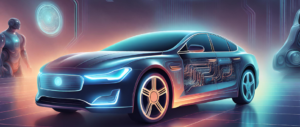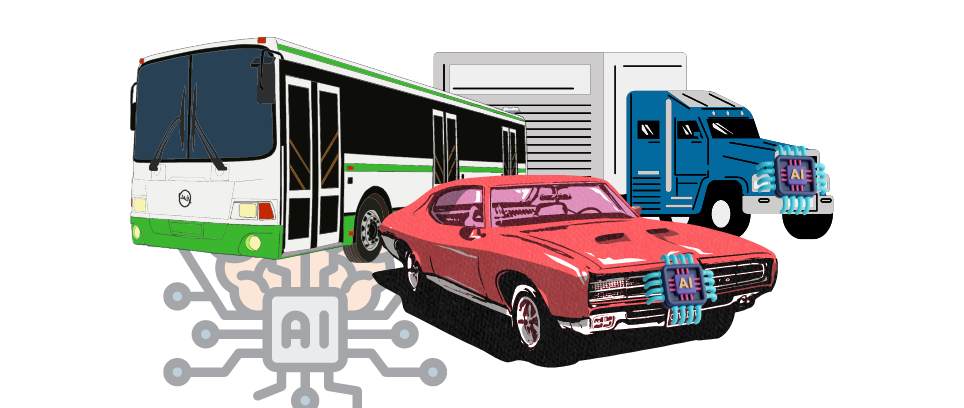The influence of Artificial Intelligence (AI) extends across various business sectors, with its most pronounced effects observed in manufacturing and automotive industries.
Forecasts indicate a staggering compound annual growth rate of nearly 40 percent for AI in the automotive sector, projecting a market value of $15.9 billion by 2027.
This surge is fueled by rising consumer demand for connected vehicles and advanced technologies like voice and image recognition.
Consequently, the automotive industry is poised to remain heavily dependent on AI and automation throughout the automotive lifecycle, from design and production to vehicle usage.
Expanding Horizons: AI’s Role in Automotive Innovation
While autonomous vehicles often steal the spotlight, AI’s impact on the automotive sector extends far beyond self-driving cars. Beneath the surface lies a complex ecosystem where AI and automation are integral to every aspect of vehicle design, production, and beyond.
In manufacturing, automation and smart robots have revolutionized production lines, streamlining processes and enhancing efficiency. These technologies play a pivotal role in assembling not just cars but also the myriad components that make up each vehicle.
Moreover, AI has transformed the synergy between production and sales. By analyzing sales and vehicle data, predictive modeling optimizes production schedules to align with real-time demand. This adaptability has proven crucial, particularly in navigating supply chain disruptions, as evidenced during recent global crises.
Is AI Revolutionizing the Automotive Industry?
AI has made its way into the automotive industry, bringing with it a wave of innovation and transformation.
Let’s delve into the exciting developments and prospects of AI in the automotive industry, providing a comprehensive 2024 outlook.
1. The Rise of Self-Driving Cars
In this section, we will explore the advancements in autonomous driving technology and how AI plays a crucial role in making self-driving cars a reality. From sensor fusion and computer vision to machine learning algorithms, AI enables vehicles to perceive their environment, navigate complex roadways, and adapt to changing conditions.
2. Intelligent Safety Systems
Safety has always been a top priority in the automotive industry, and AI is taking it to the next level. We will delve into how AI-powered safety systems such as collision detection, adaptive cruise control, and lane departure warning are enhancing driver safety and reducing the risk of accidents.
3. Personalized Driving Experiences
Gone are the days of one-size-fits-all driving experiences. AI is ushering in a new era of personalization, where vehicles adapt to individual preferences and behaviors. We will discuss how AI algorithms can learn driver patterns, preferences, and habits to provide personalized recommendations, adjust vehicle settings, and enhance overall driving comfort. From voice assistants to intelligent infotainment systems, AI is making driving more enjoyable and tailored to each individual.
4. Enhancing Traffic Management and Infrastructure
AI’s impact extends beyond individual vehicles to improving traffic management and infrastructure. We will explore how AI is used to optimize traffic flow, reduce congestion, and enhance transportation efficiency. Intelligent traffic systems, connected vehicles, and predictive analytics are transforming the way cities manage their transportation networks, leading to smoother commutes and reduced environmental impact.
The Automotive Value Chain
The automobile value chain is a complex network of organizations and processes involved in the production, distribution, and sale of automobiles. It encompasses various stages, from the design and development of vehicles to their manufacturing, marketing, and after-sales services. Each stage in the value chain plays a crucial role in bringing automobiles from concept to consumers’ hands.
A. Research and Development (R&D)
The value chain begins with R&D activities, where automotive manufacturers invest heavily in designing and engineering new vehicle models, technologies, and features. R&D teams work on innovations in areas like fuel efficiency, safety features, connectivity, and autonomous driving.
B. Design and Engineering
Once the R&D phase is complete, designers and engineers translate concepts into tangible vehicle designs. This stage involves creating prototypes, conducting simulations, and refining the aesthetic and functional aspects of the vehicle.

C. Manufacturing
The manufacturing stage involves transforming the vehicle designs into physical products. It includes processes such as stamping, welding, painting, assembly, and quality control. Manufacturers operate production facilities that leverage advanced technologies and automation to ensure efficient and high-quality vehicle manufacturing.
D. Supply Chain
The supply chain encompasses the sourcing of raw materials, components, and parts needed for vehicle production. Automakers work closely with suppliers to ensure a steady supply of high-quality components. Supply chain management focuses on logistics, inventory management, and maintaining strong relationships with suppliers.
E. Distribution and Sales
Once the vehicles are manufactured, they are distributed to dealerships through a network of logistics and transportation. Dealerships play a vital role in marketing, showcasing, and selling vehicles to customers. They provide customer service, handle sales transactions, and offer after-sales support.
F. After-Sales Service
The automobile value chain includes the provision of after-sales services such as maintenance, repairs, and warranty support. Service centers and authorized workshops ensure that customers receive timely and reliable assistance to keep their vehicles in optimal condition.
G. End-of-Life Management
Responsible end-of-life management is an essential part of the automobile value chain. It involves recycling and disposing of vehicles in an environmentally friendly manner. This includes proper disposal of hazardous materials and the recycling of reusable components and materials.
The automobile value chain is a complex and interconnected ecosystem involving numerous stakeholders, including manufacturers, suppliers, dealerships, service providers, and customers. Each stage contributes to the overall value creation and ensures the delivery of safe, reliable, and high-performance automobiles to consumers worldwide.
Challenges and Opportunities
1. Data Privacy and Security
With the increasing reliance on AI in vehicles, there are concerns regarding the privacy and security of data. The collection and utilization of vast amounts of personal and vehicle data raise questions about data protection and cybersecurity measures.
2. Ethical Considerations
The rise of autonomous vehicles introduces ethical dilemmas. For instance, in situations where accidents are unavoidable, AI algorithms must make split-second decisions that prioritize human safety. Resolving these ethical concerns requires careful consideration and industry-wide discussions.
3. Skill Gap and Workforce Transformation
The integration of AI technologies into the automotive industry necessitates upskilling the workforce. Professionals in the field need to acquire expertise in handling advanced technologies, data analytics, and AI-driven systems. Bridging the skill gap and fostering a culture of continuous learning is crucial for successful AI adoption.
Use Case Studies
-
Tesla Autopilot
Tesla’s Autopilot system exemplifies the integration of AI and machine learning in semi-autonomous driving capabilities. It utilizes sensors, cameras, and AI algorithms to assist drivers, enhance safety, and enable features such as lane-keeping and adaptive cruise control.
-
Waymo
Waymo, a subsidiary of Alphabet, leads the way in autonomous vehicle technology. Their self-driving cars leverage AI algorithms for safe navigation and have accumulated millions of miles on public roads, driving advancements in the field.
-
NVIDIA DRIVE
NVIDIA’s DRIVE platform empowers autonomous vehicles with advanced computing capabilities. It provides AI-based solutions for perception, localization, and planning, enabling vehicles to process sensor data, understand their surroundings, and make informed decisions in real time.
AI’s impact on the automotive industry is poised to be transformative. From enhancing safety to revolutionizing mobility, AI is driving innovation at every stage of the automobile value chain.
Buckle up and get ready for an exciting future where AI and automobiles come together to shape a new era of transportation.
 Pin
PinJoin Accredian and start your journey from insights to algorithms today! With our extensive collection of Data Science resources, pursue a fulfilling career in data science.
Let’s make your data-driven dreams a reality!
Contact us for any questions or comments.






